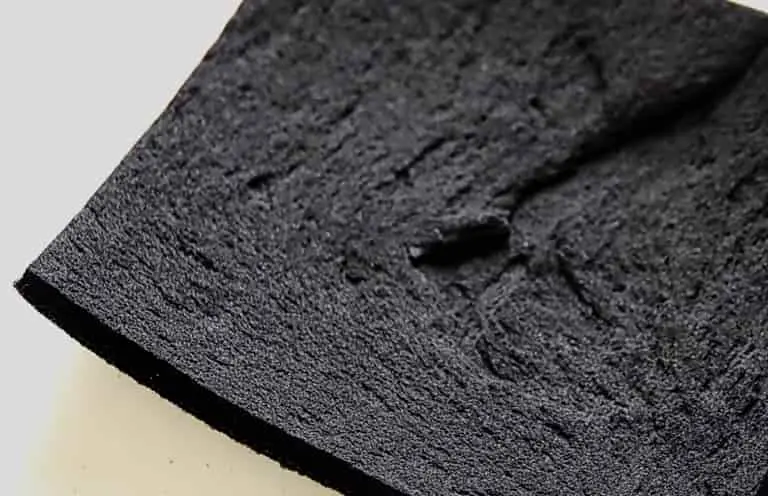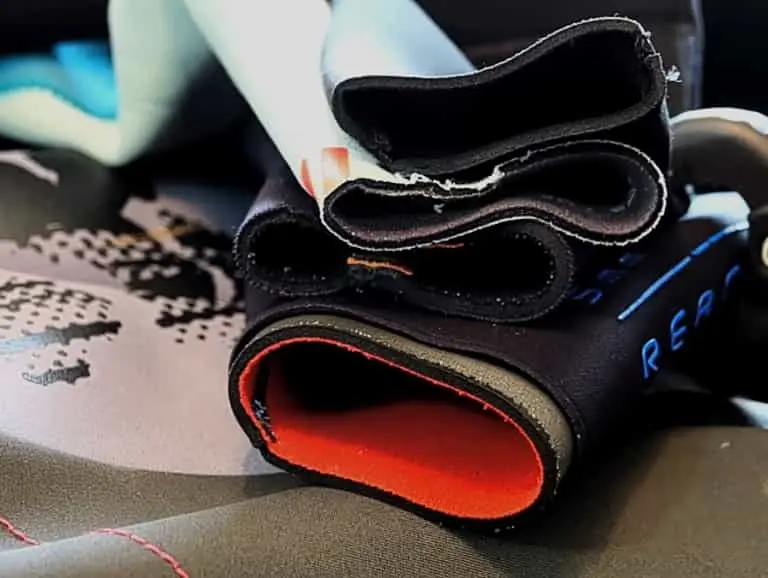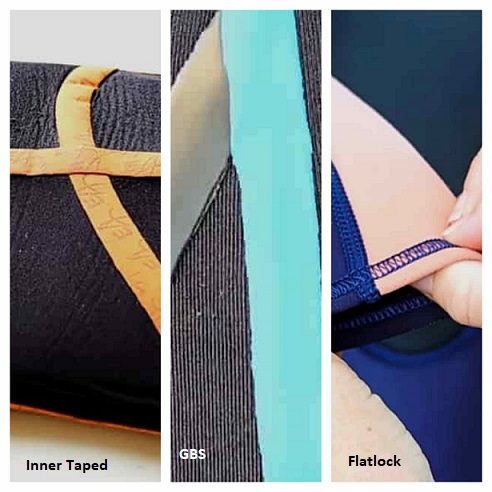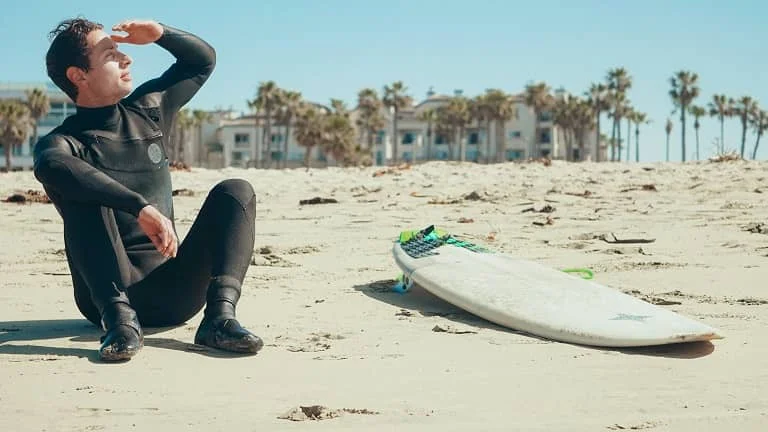When it comes to surfing or kayaking in cold weather, you know that the right wetsuit is one of the most crucial pieces of gear. Whether you’re looking for a spring suit, a fullsuit designed for cold water, or something in between, the right wetsuit can make the difference between an amazing surf session and an uncomfortable one.
Between fit and construction type, there are many factors to consider when selecting a new suit. All these choices can make it hard to determine what’s best wetsuit for your style of surfing or kayaking, body type, climate, and budget.
That’s why we put together this guide on what to look for in a wetsuit. Below we cover everything from finding your ideal thickness to choosing your preferred closure system — so you will be able to find the perfect fit for all your surf trips or kayaking in cold weather!
Table of Contents
6 most important things to look for in a wetsuit
Material

Neoprene is a synthetic rubber, meaning it’s made from petroleum. The material has been around for decades and has proven to be an effective material for wetsuits.
It’s flexible and durable, giving you the freedom to move in your suit without any chafing or rips. It also makes the water feel warmer than it is, so you don’t need to worry about getting cold during your swim.
Neoprene isn’t just a great choice for athletes—it’s also good for our environment! In fact, creating neoprene uses less energy than creating polyurethane (PU), which many companies use in their suits instead of neoprene because it’s cheaper but not as good at keeping swimmers warm or flexible enough to move in their suits comfortably
Thickness

Thicker suits are warmer, but at the same time, they can be more restrictive and bulky. Thickness is also important for durability: a thicker suit will last longer than one that’s thinner.
In general, you should look for a wetsuit with a thickness of around 3mm (2 to 3/4 inches) for kayaking. This allows for good warmth without restricting your movements too much.
Durability
A good wetsuit will be made from neoprene, a synthetic rubber. Neoprene is one of the most common materials in wetsuits due to its durability, resistance to abrasion and tearing, and ability to keep water out.
To make sure you’re getting a durable product–and not just one that’s been sitting on a rack for years–look for these things:
- A thick layer of neoprene around the chest area (the armpits) and arms, as those are places where wear is most likely.
- Reinforced seams so they don’t rip easily under pressure or when rubbing against something else like your skin
- Reinforced stitches along all edges where two pieces of material overlap each other
Flexibility
Flexibility is important for comfort and movement, but it also plays a key role in safety, warmth, and water resistance. The more flexible your wetsuit is—which means it stretches more—the better you’ll be able to move your arms and legs as you swim.
If the neoprene rubber material is stiffer than necessary, it won’t move with your body like it should. That could lead to muscle cramps or joint injuries over time.
Flexibility also contributes to warmth by keeping the heat in the core of the body where it belongs instead of letting cold water seep through seams that aren’t properly sealed or don’t have enough stretch to accommodate movement while swimming.
This means less overheating when you’re wearing a wetsuit during exercise on dry land too! And lastly: flexibility makes life easier on both swimmers who are getting into and out of their gear quickly before practice begins every morning (or evening).
Construction
Wetsuits are constructed using different methods. Some of them will give the wetsuits better protection while others less. Hence their price varies depending on their construction methods. Let’s learn about them briefly.

- Glued and Blind Stitched (GBS): These are used for cold water wetsuits. To prevent leakage the needle goes only half of the neoprene during stitching. In this GBS method, Gluing on the stitched side, make it the strongest blindstitched seam.
- Liquid sealed seams: This method is one step ahead of GBS. Using a seal on the top of the blindstitched seam can be reinforced. This method is commonly known as S-seal. The liquid seam method provides extra protection from water entering the wetsuit.
- Tape inside seams: If you want a more durable wetsuit from many on the market, go for a tape inside type constructed wetsuit. They are made by reinforcing the GBS from the inside using tape. This type of wetsuit protects you from skin rash.
- Flatlock seams: This method is used for making very thin or warm water wetsuits. They are cost-effective because they do not require much protection from cold. Hence they do not require any advanced method for sealing like the previous methods we discussed.
Entry systems of wetsuit
When choosing a wetsuit, it is helpful to know what each of the different entry systems is like, so you can weigh their pros and cons and decide which ones are right for your needs.
Generally, three types of entry systems are found in the market nowadays. These are zipper-less, front zip and back zip entry system wetsuits.
Zipper-less wetsuits
Zipper-less wetsuits are a rare breed. There are only a handful of companies that make them, and those tend to be high-end or expensive. But if you’re interested in getting one for yourself, do it!
They’re incredibly easy to use, so much more comfortable than zippers and they allow for full freedom of movement during swimming or surfing. The only downside is that zipperless suits are typically more expensive than their zip counterparts.
Chest zipper wetsuits
A chest zip entry system is one of the most common and convenient ways to go about putting on a wetsuit. It allows you to easily enter and exit the suit, which is great for people who are new to diving or just want an easy way out of their gear at the end of a long day in the water.
A chest zip also allows you to wear your wetsuit over other clothing, like a long-sleeved shirt or sweater. If you don’t want to take off your shirt before getting into your wetsuit (or vice versa), this makes it easy!
Back-zip wetsuits
You’ll find the zipper in the back of most wetsuits, from entry-level products to high-performance ones. It’s a tried and true design that’s been around for decades, and we think it’s the best way to go. The zipper is simple and easy to use—you just have to pull it up!
Plus, if you’re wearing your suit with a backpack or other gear that might get caught in the zipper teeth as you zip up your suit (or try to unzip), zips on both sides of the jacket would be more prone than one single side zipper system.
There are some tradeoffs here: back-zip wetsuits can be more difficult when getting into them after coming out of cold waters—it takes some practice! Also, surfers may want an alternate way of getting water out from under their wetsuit after taking off their board or catching waves at high speeds because these entry systems tend not to allow much ventilation through this area once fully zipped closed.
Conclusion
If you are new to surfing, the choices and options can be overwhelming. With sun protection, stretchy neoprene, and quick-drying fabrics the newest wetsuits have come leaps and bounds from our humble beginnings in the ’60s or even just a few years ago.
Whether you need a fullsuit for cold climates or a spring suit for warm days at the coast, we are sure to have something that meets your needs and budget. Now that you know what to look for in a wetsuit when buying them, get out there and catch some waves!



Pingback: What to look for in a drysuit for a comfortable watersport - Safekayaking